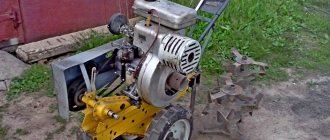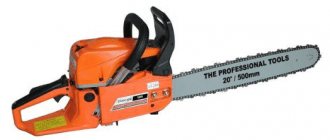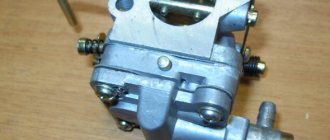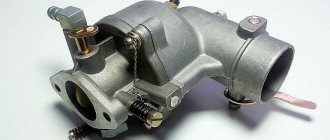Neva walk-behind tractors have long won the recognition of farmers and owners of countryside plots. However, in order for equipment to serve for a long time and work properly, it must be used correctly. Proper engine maintenance is extremely important, but the carburetor is equally important.
Its task is to enrich the fuel with air and transport the combustible mixture to the engine. In order for this part to work smoothly, it requires adjustment from time to time. This allows you to minimize the amount of fuel consumed and increase the productivity of the device - a motor-cultivator or walk-behind tractor. Our article is devoted to how to properly adjust the carburetor of a Neva walk-behind tractor.
Don't forget to adjust the carburetor
How to adjust the carburetor of a walk-behind tractor with your own hands
The walk-behind tractor carburetor must be adjusted periodically to ensure proper operation of the mechanism. A possible cause of differences in the operation of the walk-behind tractor engine may be the carburetor. To do this, the device is disassembled, cleaned and adjusted (adjusted). Regardless of the brand of carburetor and the device on which it is installed, the principle of regulation is the same for everyone. The difference can only be in the number of revolutions.
Adjustment features of different brands
As noted earlier, the carburetor of a walk-behind tractor is configured in the same way, regardless of the brand: Neva, Cascade, Agros (or Argo, as it has been called since 2012), Lifan and others.
If, after carrying out all the manipulations described above, the carburetor continues to operate incorrectly, it will need to be removed and inspected. The unit may need repairs, cleaning or washing of parts.
After adjustment, be sure to check the spark plugs for dirt: clean them from carbon deposits or replace them if they are faulty, adjust the spark plugs.
How to adjust the carburetor of a walk-behind tractor
What should you pay attention to during a motor failure? If a carburetor malfunction occurs, the first thing you need to do is check the fullness of the fuel tank and the oil level. If there is enough fuel and oil, then proceed to inspect the spark plug. To do this, unscrew it and use the ignition to check the spark. Next, the flow of gasoline to the carburetor is tested. For this purpose, remove the hose from the fitting and monitor the flow of fuel. If fuel does not appear, then the filter mesh will most likely need to be cleaned. To do this, the fuel valve is unscrewed and all parts are washed with gasoline. The same is done with the carburetor jet.
Cleaning the carburetor is carried out as follows. To clean the device, you first need to remove it. To easily remove the carburetor, you need to carefully inspect the body of the device and unscrew all the parts on which it is supported.
So, remove the carburetor and pour gasoline out of it. Carefully separate all parts of the device (nozzle, float) for further purging and cleaning. This manipulation is performed with a special cleaner.
In case of heavy contamination, you can use a compressor.
After cleaning, thoroughly dry all the parts and safely proceed to assembly. After assembly, adjust the carburetor for the walk-behind tractor.
We install the cleaned device using the standard gasket and secure it with nuts. Don't forget about the air filter, speed controller and gasoline supply hose.
Setting up the carburetor of a walk-behind tractor involves adjusting it. In order to adjust the carburetor yourself, you need to do the following steps:
- The low and full throttle screws must be tightened until they stop.
- Turn out the low and full throttle screws one and a half turns (we set the throttle valve in such a position that a gap of the appropriate size is formed between the base and the air duct).
- Start the engine and wait until it warms up.
- With the engine running, set the control lever to minimum speed.
- Achieve uninterrupted engine operation. To do this, you need to keep the idle speed to a minimum using the throttle screw.
- Set the idle speed to maximum using the idle screw.
- Set the idle speed to minimum using the throttle screw.
- Repeat steps 6 and 7 until continuous engine operation begins.
- Place the engine control lever on the gas.
- If an interruption occurs, unscrew the screw that regulates the quality of the mixture no more than 2.5 turns.
I would like to note that the carburetor adjustment on the Neva walk-behind tractor is carried out strictly according to the above instructions. The K-45 device installed on the Neva walk-behind tractor is single-chamber and horizontal. The float chamber is located in the central part. The throttle valve is flat.
The Neva walk-behind tractor uses the DM-1K engine, which is produced on. The manufacturer categorically does not use Chinese-made engines. This also applies to the production of motor cultivators.
Possible faults
The main problems that arise during the operation of the unit include:
Excess air intake. In this case, you should change the gasket between the carburetor and the cylinder head. The problem may be due to insufficiently tightened mounting nuts, but a worn shaft on the throttle valve could also be the cause. It will need to be replaced. Pay attention to the holes where this shaft is attached. It happens that they wear out and become broken. In this case, the entire device must be replaced. Overflow of the float chamber, due to which excess fuel enters the combustion chamber, or a lack of fuel appears in it
In any case, it is important to check the shut-off needle, jets and float for wear. Insufficient fuel supply to the carburetor. You will need to check the condition of the fuel filter and sump, gasoline supply hoses and the tank itself
If the fuel tank is rusty from the inside, it must be cleaned with caustic soda or replaced. Otherwise, debris will continue to enter the system, and filters and main channels will become clogged. Excessive gasoline consumption. This effect may be a consequence of an incorrectly configured fuel supply system. Fix the problem by adjusting according to the recommendations from the instructions.
Sometimes complete disassembly is required. This procedure is performed in several stages:
- dismantling Carried out from the engine head;
- removing any remaining fuel that may accumulate in the float chamber. You need to drain it or soak it with a sponge;
- inspection of the float fitting. If the fuel drips very slowly, then it needs to be blown out with air using a compressor;
- 180° scrolling of the fitting. If the manipulation helps to stop the flow of fuel from the carburetor, then this means that the gasoline valve is not yet worn out.
After everything, you need to check the jets. This procedure includes:
- unscrewing and removing the screws that provide gas adjustment;
- dismantling the upper and lower housing covers;
- flushing the jets, cleaning the fuel tap. For these purposes, you need to use kerosene or gasoline. Air purging from the compressor will be required.
Important: after all manipulations, the spare parts should be dried thoroughly by placing them on a clean rag for a while. Reassemble in reverse order
If during the overhaul you find signs of wear on the body, then it is better to replace the part completely with a new one.
https://youtube.com/watch?v=BWtdhQjH4HQ
Carburetor operating instructions
The gasoline that enters this device must not contain mechanical impurities. All parts are processed exclusively with gasoline. The use of solvent is not allowed, as the elasticity of the washer and rubber parts is damaged.
To dry parts, use compressed air. It is not recommended to clean small holes with wire or a needle. Installation after repair or cleaning must be carried out evenly to avoid bending or deformation of parts.
The float chamber must be tightly connected to the body. Before operation, you need to check the connection of the air filter. There should be no gasoline leaks.
Before starting the engine, you should prepare the carburetor. To do this, you need to make sure that gasoline does not leak from it. To do this, just open the fuel tap. Close the air damper and tighten the control lever until it stops. Open the throttle valve to 1/8 - 1/4 of the maximum stroke. At low air temperatures (below +5ºС), squeeze the seal until fuel comes out of the hole.
During startup, open the choke slightly, and after the engine warms up, open it completely.
How to set the ignition correctly
The operation of any device begins with starting the engine and the ignition system must work no worse than a Swiss watch.
But if the functionality of this element is impaired in one way or another, it is necessary to adjust it.
Before setting the ignition on the walk-behind tractor Luch, Don, Huter, Profi, Plowman, Champion, you must first of all:
- Check the spark plugs. They are the main reason for the failure of this system. It is also always recommended to have a spare candle with you, in case manipulations and cleaning do not help. To deal with the spark plug, you need to unscrew it and wipe the electrodes and remove carbon deposits from them.
- Next, you need to set a gap between them.
- Next, put the wire square on the spark plug, and firmly press its body against the cylinder, its head, while turning it away from its hole, which is located in the cylinder head.
- It is necessary to rotate the crankshaft. This can be dealt with using a starter cord. In a working system, the spark that jumps between the electrodes should be light blue. If it is missing or has a white-yellow color, the system is faulty.
After these simple manipulations, you will receive a perfectly working Luch walk-behind tractor. Installing the ignition on it is as simple as setting it up, since it consists of several parts that are connected like parts of a construction set.
All grooves are designed in such a way that nothing can be mixed up, the spark plug cannot be inserted on the wrong side, or the wires cannot be connected incorrectly
After you have adjusted the ignition of the Luch walk-behind tractor, and this part of it is working properly, you can begin setting up the next important engine component
Carburetors of the Neva walk-behind tractor: features, purpose and operating rules
A carburetor for a walk-behind tractor is a connected part of the power system. The main task is to optimize the fuel to obtain a specific composition. The carburetor first of all needs constant monitoring of loads.
Regular checks, adjustments, and proper operation will help extend the service life of the device. In addition, this is influenced by the configuration of the equipment and the fuel used.
Description and general characteristics of the carburetor
Almost all walk-behind tractors have a carburetor, which must be adjusted for proper and uninterrupted operation. The walk-behind tractor itself is used for various processes:
- plowing;
- cultivation and milling;
- hilling and watering using a pumping station;
- cleaning the area, including from snow and grass;
- harvest, for example, potatoes.
All uses are costly for the mechanism. It is for this reason that regular maintenance is required.
A number of devices and parts are of greatest importance. If you do not keep the carburetor in optimal condition, the Neva MB 2 walk-behind tractor will not be able to fully function during constant operation.
Important! Without the necessary experience, as well as an understanding of the device, it is advisable to exclude self-correction of breakdowns. This may cause serious problems.
The functionality of the engine, as well as the efficient operation of the entire walk-behind tractor, depends on the operation of the device. It is for this reason that configuration and troubleshooting should only be done with experience. The priority is to contact a specialist who will teach all the rules, as well as the adjustment process itself.
Device Features
The walk-behind tractor is a fairly powerful unit, with great strength, but at the same time of medium size, equipped with multifunctional equipment. The equipment is mainly produced with a gasoline, diesel or electric engine. The latter, by the way, are extremely rare. A carburetor is required for the added fuel to ignite. The manufacturer presents the following types:
- rotary - the simplest in structure, they are mainly equipped with small-sized engines of 12-15 cubic inches;
- plunger - in this case the design is more complicated, therefore it is used for assembling powerful walk-behind tractors.
Carburetion is carried out using the main parts:
- main piston;
- connecting part - fitting;
- fuel tank;
- high/low speed needle;
- Venuri tube.
So, the process begins with a piston moving upward, resulting in the creation of a vacuum. The carburetor absorbs air, and it subsequently moves through the Venuri tube. The movement of fuel (from the tank) is directed towards the engine, this is done using a connecting fitting, which operates due to the created vacuum. The liquid goes around the main needle, flows through the inlet socket, entering the Venuri tube. By pressing the gas lever, fuel is released due to the low speed needle. Next, the first needle is responsible for the flow of gasoline.
Among domestic craftsmen and agricultural workers, equipment of the Russian brands “Neva”, “Oka”, “Agro”, “Utra” is especially popular. It features optimal equipment, a high-quality, powerful carburetor. Russian buyers especially appreciate the Neva K-45 walk-behind tractors for their reliability and durability. The KMB-5 model is an older unit, so before purchasing, consult with a specialist who will provide a product that meets your needs.
For heavy loads, it is recommended to use MB-2 walk-behind tractors - they are equipped with powerful engines and feature reliable carburetors that can operate for many years without forced repairs. MB-1, in turn, is considered a lightweight type that optimizes the functional engine.
What is a Neva 2 walk-behind tractor?
The powerful motor unit produced is equipped with three engine options for the walk-behind tractor:
- Gasoline engine produced by the Kaluga plant, the most often used modification is DM-1, DM-2, with a power of 6 and 7 hp. respectively. The first works on the A-76, the second on the A-95. In this case, the letter “K” is added to the walk-behind tractor index according to the instructions;
- American engines from Briggs & Stratton. The version of the walk-behind tractor with the index “B” is considered the most reliable and easy to maintain, even without any instructions;
- Subarov engines, when equipped with them, the Neva walk-behind tractor is assigned the index “C”. The engines have a similar power of 6-7 horses, but there are also diesel versions with colossal torque. The most capricious in maintenance and operation, all operations, even refueling and starting, must be performed only according to the instructions.
To find out what specific fuel is used for a particular walk-behind tractor model, you need to check the passport and operating instructions. For example, an attempt to fill a Subarov engine with 92-octane gasoline during operation can lead to burnout of the piston system, and walk-behind tractors with American Briggs often experienced serious problems with starting and controlling engine speed due to the large amount of dirt in domestic fuel.
- The mass of the unit when charged reaches 100 kg. This is the average for most walk-behind tractors; Chinese heavy versions can reach 150-180 kg;
- Motor power -6 hp, with a torque of 180 kg?s, for a diesel engine the torque is increased to 220 kg?s;
- The plowing depth according to the instructions, when using a standard plow, on a walk-behind tractor reaches 200 mm, the maximum harrowing width is 170 cm.
The machine can plow, harrow, dig up potatoes planted in beds, clear snow and much more, provided that the standard attachments specified in the operating instructions are used.
Adjustment recommendations
Unstable engine operation is the first signal to adjust the carburetor on the walk-behind tractor. Experts advise starting this procedure in early spring - just when you start the mechanism after winter “hibernation”, at the end of autumn - after the end of the load. Disassembly should be carried out in a bright, ventilated area. Setting up the Neva carburetor yourself is not at all difficult, the main thing is to follow the basic recommendations:
- warm up the engine for at least 5 minutes;
- screw the screws in until they stop;
- the screws, in turn, must be adjusted by 1.5 turns;
- set the gear lever to minimum speed;
- in the case of throttle control parts, set only the minimum speed;
- Make sure that the engine is running for the duration of the entire repair - turn it off when completed, then start it again to check/monitor the result;
- The idle speed is regulated by the idle screws - it is important to ensure non-stop operation of the engine;
- If all rules are followed, the carburetor will function quietly and without failures.
Adjustment
Every user has encountered the problem of unstable carburetor operation, since over time any equipment can fail. This is one of the first reasons why there is a need to independently adjust the operation of the unit.
Experts advise following the sequence of actions if you do the setup yourself:
- at the first stage, the user is required to turn the throttle screws all the way, and then half a turn;
- activate the ignition and allow the engine to warm up a little;
- without turning off the unit, set the speed lever to the minimum permissible mode;
- start idling to the maximum possible;
- turn on idle speed again to minimum;
- These last few steps will need to be repeated several times until the motor begins to demonstrate stable operation;
- at the end the control lever is set to gas.
Operating rules
The device will last a long time if you follow the following recommendations.
- To keep the mechanism in working condition, it is important to monitor the composition of the supplied gasoline - it should not contain mechanical impurities.
- Before starting repair work, it is necessary to treat the parts with the same fuel. It is not recommended to use solvent, as it can reduce the elasticity of rubber parts and damage washers.
- It is best to dry parts by blowing with compressed air.
- Do not clean small holes, for example, with a needle or wire.
- Perform final assembly and installation of parts evenly - this way you can avoid deformation or bending of carburetor parts.
- Make sure that the float chamber is tightly connected to the body - future success lies precisely in their tightness.
- Before starting the mechanism, check how the air filter is connected - you should be wary of fluid leaks.
- To avoid leakage, the fuel valve must be opened, then the air damper must be closed, the control lever must be tightened tightly, and the throttle valve must be opened to 18-14. The seal should be pressed until drops of fuel appear (if the temperature has dropped to 5 degrees).
- When starting, the air damper must be opened slightly. As soon as the engine warms up, open it all the way.
Main malfunctions of walk-behind tractors "Cascade"
What malfunctions can occur in the operation of Cascade walk-behind tractors? Let's take a closer look at possible causes not related to engine malfunction:
- The car does not go forward/reverse. Possible cause: belt break or insufficient tension. Solution: replacing the belt, adjusting the tension.
- There was a delamination of the belt on the V-belt drive. Possible cause: excessive belt wear. Solution: replacing the belt.
- Skidding of soil areas during plowing. Reason: insufficient weight of the unit. Solution: use weights and lugs.
These reasons are not related to serious repairs to the Cascade walk-behind tractor. Next, we will look at the causes of engine malfunction and possible ways to eliminate them.
Table of engine malfunctions of the "Cascade" walk-behind tractor
| Malfunction: The Cascade engine stalls during operation and does not start. |
Reason: no fuel in the tank; the fuel system is clogged; carburetor is out of adjustment; The carburetor is clogged.
Repair: gas station; cleaning the fuel filter and hoses; it is necessary to adjust the “Cascade” carburetor; cleaning the carburetor.
The design of the Cascade walk-behind tractor is simple and classic. Like any similar unit, the “Cascade” consists of a steering rod, a two-wheel chassis, an engine and a power transmission.
Behind the engine there is a transmission, gearbox (gearbox), clutch, main gear, differential, final drive and PTO.
Carburetor care for walk-behind tractor
It is possible to prevent the walk-behind tractor from frequent breakdowns or repairs only by carefully monitoring the operation of the mechanism. As has already become clear, it is important to carry out timely idle adjustment. In addition, do not forget to clean the carburetor, inspect the condition of the parts; to do this, you must first remove them; perhaps they need a complete replacement. For example, gaskets often wear out. Due to constant interaction with fuel liquid and air, the engine becomes heavily polluted. The filters that are installed on the unit will help reduce manual cleaning. In this case, they will have to be cleaned when they become very dirty.
The condition of the equipment is affected by the composition of the fuel being poured. Low-quality flammable liquid impairs the functioning and service of parts and the mechanism as a whole. It is for this reason that craftsmen often resort to replacing or repairing agricultural equipment. You can purchase new spare parts at automobile markets or in stores staffed by qualified specialists.
It is enough to name the model and serial number of the equipment, and you will be provided with appropriate assistance and a selection of quality parts. By the way, right in the store they can diagnose, clean, and replace you.
It is quite easy to adjust the Neva brand device even with your own hands. The main thing is to adhere to the above rules. It will not be superfluous to purchase a connection diagram for each part after repair work or setup, since incorrect installation of spare parts will lead to equipment malfunction - it simply will not start. Try to use high-quality fuel, make adjustments on time, and do not skimp on spare parts. After all, the operation of the entire mechanism depends on every detail.
In the next video you will find cleaning and flushing the carburetor from the Neva MB23 walk-behind tractor.
Features of adjusting the KMB-5 Cascade carburetor
- All gasoline must be removed from the float cavity.
- We supply the air mixture through the fuel supply fitting.
Proper adjustment is confirmed by the unimpeded air supply when the walk-behind tractor is in operation and the blowing stops when the part is turned over.
Adjusting the K-60 carburetor of the Cascade walk-behind tractor
- We install the throttle valve so that we have a gap of 2 - 2.5 mm between its base and the air duct.
- We tighten the carburetor screws.
- We turn the screws back only 0.5 - 1 turn.
- Warm up the engine for 5 minutes.
- While unscrewing the adjusting screw, wait for the engine speed to decrease.
- We reduce the rotation speed and smoothly tighten the screw to the optimal state.
Adjusting the K-45 carburetor
The essence is basically the same as in previous models:
- We need to reduce the engine speed by controlling the throttle stop screw.
- Next, you need to determine the maximum speed value using the screw to adjust the fuel mixture at idle.
- Then we turn the screw back about a quarter of the achieved position.
Such manipulations will allow the motor to operate smoothly, steadily and without sudden stops.
It is important to remember that each model has its own setting for the normal operation of all parts. To make quality repairs yourself, be sure to follow all the instructions in the manufacturer’s instructions.
If you don’t have it, then you should be extremely careful when repairing it. For those who do not have special knowledge in assembling and repairing such technical equipment, it is better to contact specialists at a service center. This will help you avoid many problems, and professionals will be able to quickly fix everything.
Delivery in Moscow
For orders in Moscow we offer the following delivery options.
- Pickup. Possible for goods that are in our warehouse at Ilmensky proezd 7A bldg. 8 or by pre-order.
- Courier delivery . Price - 350 rubles. Delivery next business day after placing your order
Free delivery within the Moscow Ring Road is available for order amounts over 5,000 rubles
Delivery outside the Moscow Ring Road and in the Moscow region
- Delivery within 5 km from the Moscow Ring Road - 500 rubles
- 500 rubles +40 rubles per kilometer
- Delivery within 5 km from the Moscow Ring Road - free
- Delivery over 5 km from the Moscow Ring Road - +40 rubles per kilometer
Delivery by our transport to neighboring areas is subject to additional agreement.
Delivery across Russia
- For order amounts up to 5,000 rubles
- Delivery by Russian Post with payment upon receipt. Price - 350 rubles (includes all postage costs. Postal delivery is not available for order amounts over 5,000 rubles.
- Delivery by transport company. Will be carried out only after full payment of the order. We will order cargo collection by any transport company of your choice. We work with most transport companies in Moscow. Payment for delivery according to the tariffs of transport companies.
For order amounts over 5,000 rubles
Delivery by transport company. We will deliver this product free of charge to the terminal of the transport company of your choice. We work with most transport companies in Moscow.
The main power unit of the walk-behind tractor is the carburetor. It performs the task of preparing fuel to the required level. For its normal functioning, the load is regularly monitored and the condition of service is checked. Also, a lot depends on the quality of the fuel and kit used.
It is necessary to constantly check the Cascade engine
Carburetor for the Neva walk-behind tractor: adjusting the device for models MB-1 and MB-2
Motoblocks today have become a very popular technique among farmers, summer residents and rural residents. Therefore, questions about their repair and correct operation never tire of leaving the Internet. Since sooner or later the equipment breaks down for various reasons, it is necessary to either contact a service center or solve the problem yourself. Many, of course, start doing repairs at home, which is much more economical than turning to specialists. But you need to remember that it’s worth knowing how to do it, or at least have the instructions at hand.
Today we will talk about a common problem with Neva walk-behind tractors, namely, we will provide detailed instructions for adjusting the carburetor of the MB-1 and MB-2 walk-behind tractor. Everyone knows that the carburetor is a very important part in the walk-behind tractor system. The efficiency and success of the functioning of the engine and other systems depends on it. So, we will tell you step-by-step instructions for adjusting the carburetor for the Neva MB 2 and MB-1 walk-behind tractor.
Experience of owners of operating the Neva MB-2 walk-behind tractor - reviews from forums
Each farmer's experience is unique. The advice of those who use the same walk-behind tractor as you do on their plot of land is especially valuable. Next - some advice from owners of the Neva MB-2 walk-behind tractor regarding maintenance and troubleshooting.
Vitaly, Penza, Russia:
“I bought a Neva mb2 walk-behind tractor and was very pleased. The unit worked normally at first, but a week after the start of operation, white smoke began to emerge from the exhaust pipe. I tried to slow down the engine speed, but it didn't help. It turned out there was water in the float chamber. I drained the gasoline, let it settle, and drained the chamber. After that the walk-behind tractor worked perfectly. If anyone has had a similar problem, I advise you to use my experience!”
Alexey, Rostov-on-Don, Russia:
“I encountered the following problem: in first gear my walk-behind tractor cultivated normally, but when I switched to second gear and worked with the soil, the engine speed did not drop. When I went deeper into the ground, the cutters stopped. Knowledgeable people suggested that the problem might be in towing the belt. I adjusted the tensioner and shortened the chain on the clutch handle and the problem was solved! Now I work with pleasure, I’ve been using my Neva MB2 for two years now.”
Konstantin, Rivne, Ukraine:
“I’m not new to working with a walk-behind tractor; I’ve been using it for 4 years. Recently, if you put a load on it, the engine began to stall, as if it couldn’t pull... I barely drove it into the garage, and there was no popping noise, no smoke. The cause of the malfunction was simple: the air filter was clogged. I had to replace it and now the car runs like a beast.”
You can also help other readers of our site with your reviews on this walk-behind tractor model and its maintenance and main faults.
If you are the owner of this walk-behind tractor model, you can leave a review about its maintenance and operation, or ask any question you are interested in regarding the breakdown or maintenance of this model below in the comments.
Details for adjusting the carburetor of Neva walk-behind tractors
To repair this device, you can safely use these guidelines in the picture and the tips below:
- Screw in the full throttle screw No. 1 and the low throttle screw No. 2 until the end.
- We unscrew the same 2 screws approximately 1 - 1.5 turns.
- We start and warm up the engine.
- Now we set the lever that controls the throttle until the engine turns off (that is, until the moment when it corresponds to the very minimum speed).
- We set the minimum stable idle speed with screw No. 3.
- Using screw No. 2, you need to set the idle speed to the maximum level.
- We adjust the minimum stable idle speed with screw No. 3.
- We carry out steps 6 and 7 until we get uninterrupted and stable idle operation of the engine at minimum speed.
- If there are still interruptions in operation, then screw No. 1 needs to be unscrewed and screwed back in. We carry out this operation until normal engine operation resumes.
Setting up the carburetor - step-by-step instructions
- First you need to warm up the engine;
- After 5 minutes, you need to screw in the minimum and maximum throttle screws until they stop;
- Then you need to unscrew these same screws no more than 1.5 turns;
- After this, the gear shift lever is set to the minimum travel position. The motor must be running throughout the entire operation;
- Finally, turn off and turn on the engine again - you will immediately notice a change in the form of silent and continuous operation of the engine.
These procedures must be performed with Cascade walk-behind tractors before each season. Loosening the bolts enriches the fuel with oxygen, which is very important for stable engine operation.
To check that the procedures you followed are correct, you need to look at the spark plugs. After a whole day in the garden, soot or fuel residues should not appear on the candles.
Adjusting the KMB-5 carburetor on the Neva walk-behind tractor
The provided diagram will allow you to easily and simply adjust the carburetor of the KMB-5 model to Neva walk-behind tractors on your own.
This instruction is very clear and simple. By carefully following each step, you can easily resume operation of this device. Remember that in order for your unit to serve you faithfully for many years, you must do the following things:
- Carry out continuous diagnostics of the unit.
- Change the oil regularly.
- Adhere to all operating conditions.
These are key actions that will help prolong the performance of all elements and keep your equipment in shape. So follow these simple rules and enjoy the high-quality and efficient operation of your walk-behind tractor.
Other carburetor malfunctions
Main problems encountered during operation:
- Excess air leakage - you may need to replace the gasket between the block head and the carburetor or tighten the fastening nuts. The throttle shaft may also be worn out and will need to be replaced. If the holes in which it is inserted are broken, you will have to replace the entire device.
- Overflow of the float chamber, which causes excess fuel to enter the combustion chamber. In some cases, there may be a lack of fuel in the chamber. In all cases, the wear of the shut-off needle, float and jets should be checked.
- Poor fuel supply to the carburetor. You should check the condition of the fuel filter and sump, gasoline hoses and inspect the fuel tank. In cases where the tank is heavily rusted inside, it is better to replace it. In some cases, it is advisable to rinse the container with a caustic soda solution.
- Increased fuel consumption. This may be caused by improper adjustment of the fuel supply system. You should try to configure it according to the instructions.
https://youtube.com/watch?v=BWtdhQjH4HQ
In some cases, it will be necessary to completely disassemble the carburetor. To do this you need:
- remove the carburetor from the engine head;
- remove remaining fuel from the float chamber of the product;
- Next, it is necessary to inspect the float fitting. If gasoline drips from it too slowly, then the fitting should be blown out with compressed air from a compressor or cylinder;
- after this you need to rotate the fitting 180 degrees; if after these manipulations fuel stops flowing from the carburetor, this means that the gasoline valve is in full working order.
Now you need to check all the jets.
For this you will need:
- Unscrew and remove the screws responsible for adjusting the full and low throttle.
- Remove the bottom and top covers of the device body.
- Wash the jets, clean the fuel tap.
- To wash the parts, it is best to use regular kerosene (gasoline), after which it is recommended to blow them with compressed air from a cylinder.
Now you need to lay out the carburetor parts to dry completely on a clean cloth.
Reassembling the device should be carried out in reverse order only with absolutely clean and dry spare parts.
This is interesting: How to adjust valves on a walk-behind tractor - read all the nuances
Carburetor K-45 for Neva walk-behind tractor
Auto mechanic, specializes in agricultural equipment
Neva walk-behind tractors have long won the recognition of farmers and owners of countryside plots. However, in order for equipment to serve for a long time and work properly, it must be used correctly. Proper engine maintenance is extremely important, but the carburetor is equally important.
Its task is to enrich the fuel with air and transport the combustible mixture to the engine. In order for this part to work smoothly, it requires adjustment from time to time. This allows you to minimize the amount of fuel consumed and increase the productivity of the device - a motor-cultivator or walk-behind tractor. Our article is devoted to how to properly adjust the carburetor of a Neva walk-behind tractor.
Don't forget to adjust the carburetor
A few historical facts
The carburetor for a walk-behind tractor has gone through a relatively long and interesting historical path. This engine element has been modernized for a hundred years before acquiring its current appearance. The period of development can be represented in the following key events:
- Italian Luigi De Christoforis developed the first carburetor in 1876. Its functioning, compared to today's carburetors, was different. First, the fuel was heated and then mixed with air, forming the necessary mixture.
- In 1877, Wilhelm Maybach and Gottlieb Daimler, while studying this field of science, invented the first internal combustion engine equipped with a spray-type carburetor.
- On February 13, 1893, the owners of the patent for the carburetor became Hungarian citizens - physicist Donaton Banki and engineer Janos Csonka.
- The year 1911 pleased all farmers, summer residents and gardeners with the fact that Dr. von Maenburg received a patent in Berlin for the first motor cultivator. Its operation was carried out thanks to an electronic motor.
- In 1923, Siemens first offered consumers mini-units equipped with gasoline engines.
- Walk-behind tractors, similar to the units of the current type, first appeared after World War II in Germany thanks to engineer Otto Geler.
- Only since 1980, walk-behind tractors began to be introduced on the Russian market.
Today, the diversity and versatility of walk-behind tractors increasingly surprises consumers, whose life is unthinkable without such equipment.
Carburetor design
The design of the Neva agricultural machinery carburetor is quite simple. Studying it will not be particularly difficult, but at the same time it will allow you to subsequently easily carry out not only adjustments, but also repairs - if such a need arises. This part includes the following components:
- a float connected to a locking needle valve;
- float chamber;
- a chamber in which the fuel is saturated with air;
- diffuser and fuel atomization system;
- throttle valve;
- air and fuel valves.
The task of the float connected to the needle-type valve is to act as a kind of regulator, determining the volume of gasoline in the float chamber. When the amount of fuel decreases, the float moves down and opens the valve, which “admits” a new volume of fuel into the chamber, replenishing it to the required amount. As the chamber fills, the float rises and, when sufficiently filled, closes the valve, preventing excess fuel in the chamber.
In this video you will learn how to disassemble a carburetor:
The function of the atomizer, located between the float and mixing chambers, is to distribute the fuel into the mixing chamber, in which it is saturated with air. Air enters this container through the inlet pipe. It is worth emphasizing here that the gasoline level in the float tank should always be several millimeters below the outlet channel. This is important because when the unit’s engine is turned off, fuel should not splash out of the float chamber, not only when it is on a flat surface, but also when the walk-behind tractor is standing on an incline.
Carburetor Maintenance
The performance of the equipment depends on regular maintenance of the dosing unit. Its components are very sensitive to the quality of fuel and do not tolerate dirt. The main task of mechanics is to adjust idle speed. Secondary – cleaning of external and internal surfaces.
Most often, calibration jets become dirty. This occurs due to foreign substances entering the fuel system. They can be found both in gasoline and in the air entering inside. Replacing filters will help reduce the risk of contamination of the dosing device. Moving parts fail due to abrasion.
If “floating” speeds appear in the operation of the walk-behind tractor, dips in torque, or the unit begins to start intermittently, then it’s time to adjust the carburetor. By increasing the crankshaft rotation speed, the appearance of low idle speeds is “treated”. This is done by turning the adjusting screw under the throttle valve clockwise. If, on the contrary, the speed needs to be reduced, then turn the screw counterclockwise.
When adjusting the adjusting screw does not help, the system is disassembled and the fuel level in the float chamber is adjusted to normal, focusing on the position of the float. Exceeding the gasoline level is indicated by the appearance of dark smoke from the exhaust pipe, as well as traces of unburnt fuel on the spark plugs. Such malfunctions require adjustment of the float position: for this purpose, the spring mechanism of the needle valve is bent.
While the dosing unit is disassembled, its internal surfaces are cleaned and moving parts are replaced if they wear out.
How to adjust the carburetor
There are several signs that indicate that the carburetor on your walk-behind tractor needs adjustment. Let's list them:
- the engine power of the unit has decreased sharply;
- the volume of fuel consumed has increased rapidly;
- the volume of exhaust gases has increased;
- after starting, the engine turns off spontaneously;
- At idle, the walk-behind tractor engine is unstable.
Each of these problems may have several reasons, including increased loads on the unit or, conversely, long downtime of the walk-behind tractor. An effective measure to eliminate them is to set up the unit. Doing this yourself is not at all difficult. To do this, you need to perform several steps:
- Before tuning, start the engine and warm it up - leave it running for 5 minutes.
- Turn off the device and leave it motionless on a horizontal surface. After this, turn the full and low throttle screws, first until they stop, and then one and a half turns in the opposite direction.
- Start the engine again and warm up for 5 minutes.
- Without turning off, adjust the engine speed control lever to the lowest speed.
- Adjust the throttle screw to the desired position - the one in which engine operation will be the most stable.
- Unscrew the carburetor low speed adjustment screw to the maximum position.
- Set the throttle valve screw to the minimum position.
- Adjust both of the above screws until the engine of the unit begins to demonstrate maximum uninterrupted operation.
- Having adjusted both screws, you need to set the engine speed lever to maximum gas.
- A check is required to complete the setup. To do this, the maximum speed adjustment screw is turned in one direction or the other by two and a half turns in order to check the smooth operation of the motor.
Important! After you have adjusted the mechanism, you should check the unit settings. If it shows uninterrupted operation, and gasoline consumption has decreased, it means that the setting was made correctly.
Operation and maintenance of Neva MB-2
Changing the engine oil
The manufacturer recommends using such well-known brands of motor oil for the walk-behind tractor as LUKOIL - standard SAE 10W30 API SF/CC, as well as RAVENOL SAE 30 API CD/SF.
At temperatures above 4 degrees Celsius, using thickened types of oils (for example, 10W30 brand) will lead to increased consumption of this type of fuel, so in the cold season it is recommended to check the engine oil level more often, preventing its level from dropping below normal.
The oil change is carried out after the walk-behind tractor has recently been in operation, while the engine has not yet completely cooled down. It should be warm, but not hot. The remaining oil is completely drained from the tank, after which new oil is added until the oil level reaches a special mark. The drain plug is then tightened tightly and wiped dry.
First launch and testing of the Neva MB-2 walk-behind tractor
The first start must be carried out according to the following scheme:
- make sure that the walk-behind tractor is in complete condition (the height of the steering bar and handles must correspond to the user’s height);
- You can start the engine only if the walk-behind tractor is located on a flat surface;
- check the oil and fuel levels in the tank;
- also check the places of threaded connections;
- then you can start the engine by smoothly turning the ignition knob;
- The idle time (without load and movement) should be about 10 minutes, then you can move and operate the walk-behind tractor.
The break-in period is considered to be the first 20 hours of operation of the walk-behind tractor, after which the oil must be changed. During this period it is most important:
- do not operate at full throttle;
- work only on pre-prepared soils (not virgin soil);
- for cultivation, use only the number of cutters that are included in the kit;
- The Neva MB-2 walk-behind tractor can only be loaded at ¾ power during the run-in period;
- gear shifting in the gearbox can only be done when the rotation of the drive pulley has completely stopped;
After the first 20 hours of operation after the first start, the engine oil should be changed.
What is the role of a walk-behind tractor carburetor?
The walk-behind tractor is a powerful power unit that has a large number of attachments in its arsenal, which allows it to perform many functions. The basis of a modern mini-unit is an engine, mostly gasoline, although there are also diesel and electric ones. Since the fuel cannot ignite without oxygen intervention, a carburetor is used.
Two types of walk-behind carburetor designs have become popular: rotary and plunger. Each type has its own positive and negative aspects. The rotary carburetor is simpler in design and is most often found in small engines (12 to 15 cubic inches). The plunger carburetor is multi-element and is better suited for high-power units.
The carburetion process in a walk-behind tractor engine is facilitated by the following details:
- piston;
- Venuri tube;
- gas tank;
- fitting serving as a connector;
- main needle (high speed needle);
- low speed needle.
When the piston moves upward, a vacuum is created below it, and the carburetor begins to absorb air. This air moves through the Venturi tube, in the narrow part its movement is noticeably accelerated. The result of such processes is a vacuum, which facilitates the passage of fuel from the fuel inlet and transfers it directly to the engine. Fuel flows from the gas tank into the engine through the connecting fitting, then passing around the main needle, then through the fuel inlet port into the Venturi tube.
When pressure is applied to the gas lever, the low speed needle moves away from the fuel inlet, allowing gasoline to flow in; the fuel flow is then regulated only by the movements of the main needle.











